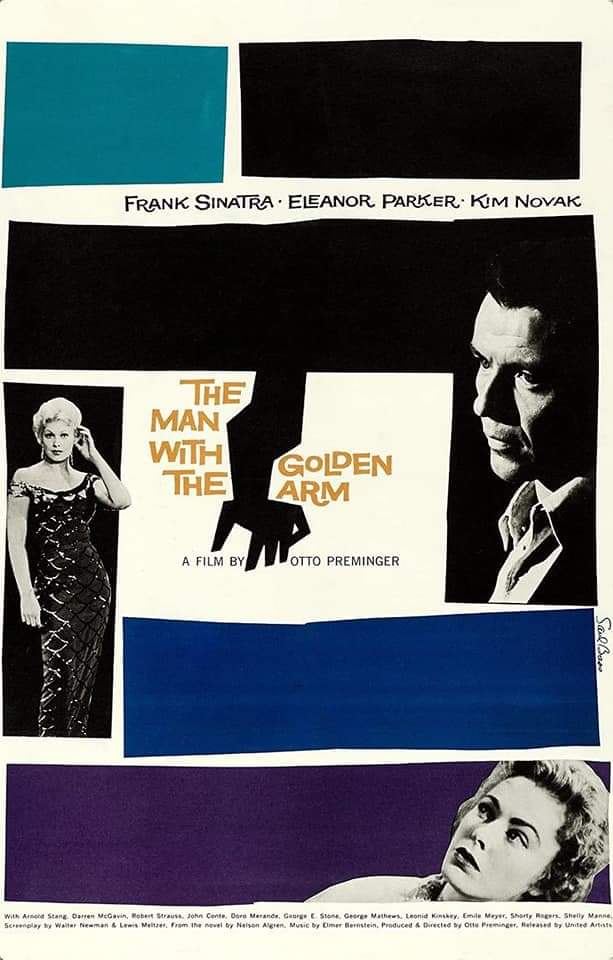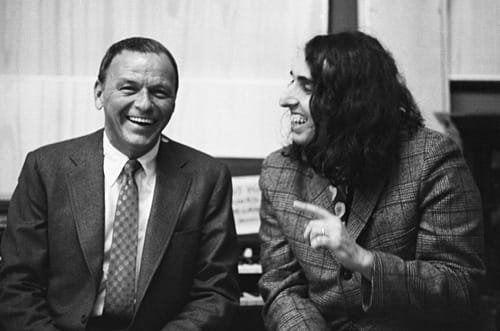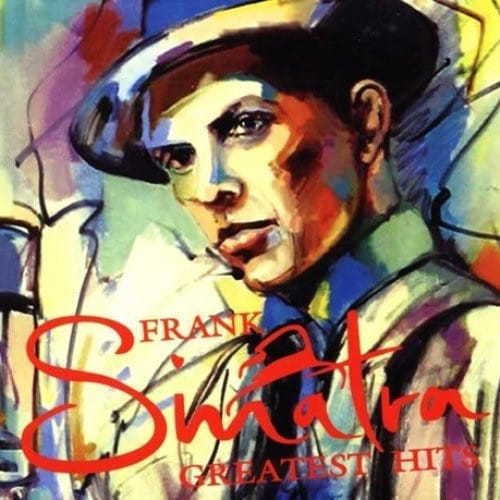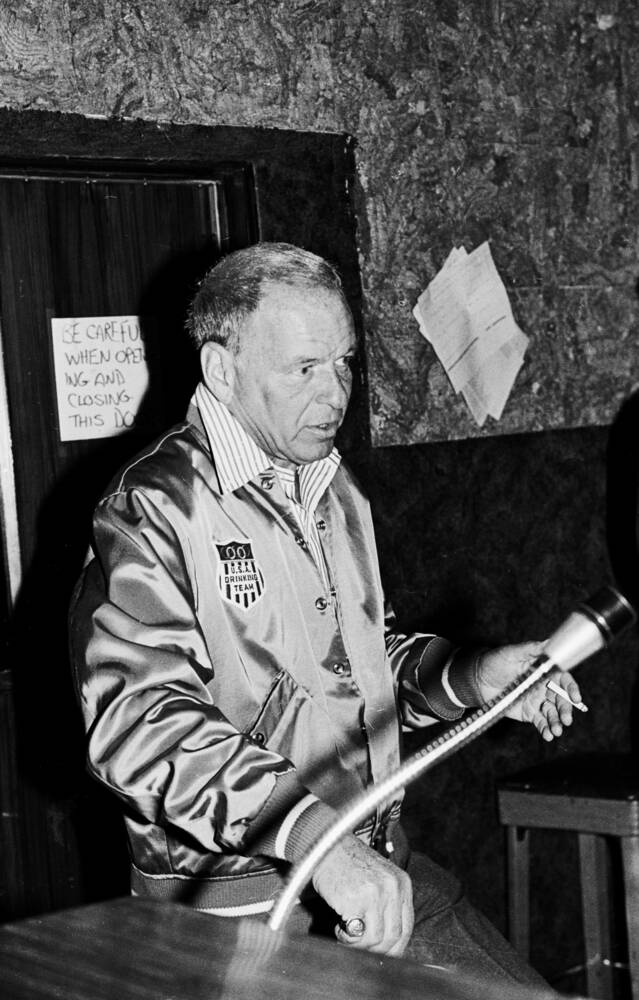
“THE MAN WITH THE GOLDEN ARM”
By Mahnuel Muñoz
In 1955 Frank Sinatra, in addition to being on the front line of music, is one of the most sought-after and prolific film stars in the world, releasing no less than five great titles as the protagonist: “Young At Heart“, “Not As A Stranger “, “Guys And Dolls“, “The Tender Trap” and “The Man With The Golden Arm“, in addition to another feature film for television (“Our Town“) and an aborted participation in the musical “Carousel“. His shocking portrayal of Frankie Machine consolidates him as a first-rate dramatic actor, after the excellent roles he played in “Suddenly” and “From Here To Eternity“; in fact, Machine, a war veteran, could perfectly be an Angelo Maggio returning to his civilian life with the terrible consequences of the war.
It is based on the 1949 book of the same name written by Nelson Algren and considered an essential title of postwar North American literature.
The film’s screenplay is by Walter Newman, Lewis Meltzer and Ben Hecht.
Otto Preminger, director of the film, bought the rights from the heirs of actor John Garfield, who would have starred in it, but he died prematurely due to a myocardial infarction in 1952. When Sinatra received the script he felt that it had been written for him, and managed to impose his candidacy on that of Marlon Brando himself. Frank’s commitment to the role even led him to accept a considerably lower salary than usual.
PLOT
After serving six months in prison for drug possession, war veteran Frankie Machine returns to his neighborhood with the intention of starting a new life playing drums in an orchestra, far from narcotics and the sordid world of illegal gambling, in those who have earned a solid prestige as a dealer.
His wife Zosch, who suffers from a disability caused by a traffic accident caused by Frankie, does not welcome him risking his lucrative job and he is torn between fighting for his dream and complying with his wife’s wishes, which It will inevitably lead you back to the hell of addiction and clandestinity.
MAKING OF
Due to the harshness of its plot (much softer than the novel), the film had to face censorship from the PCA (Production Code Authority) and the Catholic Legion of Decency, which limited the scope of its release, and Both the theaters that decided to show it and the studio, United Artists, risked being fined.
Filming began on September 26, 1955 at the RKO studios in Culver City. A small budget meant that there was no outdoor filming, which was detrimental to the quality of the street scenes.
Frank Sinatra, contradicting his earned reputation as an impatient and difficult actor, threw himself completely into the role, attending filming on time, rehearsing and repeating takes even above the demands of the director, with whom, by the way, he had an extraordinary relationship. personal and professional. He was also very considerate of Kim Novak, who at that time had little experience in front of the cameras.
To make the legendary withdrawal scene (shot in a single take) believable, Frank had the opportunity to witness the real trance of a heroin addict in a rehabilitation clinic, an experience that left him deeply shaken. Production was accelerated so that the film and its protagonist could appear as candidates for the 1955 Oscars.
The iconic poster and credits were designed by Saul Bass.
The soundtrack was provided by Elmer Bernstein and is one of the best of the 1950s.
RECEPTION
The film aroused notable controversy since the world of drugs was a taboo issue despite its undeniable presence and seriousness in social reality. Even with all the obstacles from sectors of the population and conservative organizations, it achieved great critical and public success. Sinatra’s performance was unanimously praised and nominated for an Oscar, which finally went to Ernest Borgnine for his leading role in “Marty.” He also didn’t take home the statuettes for best artistic direction and best soundtrack.
MISCELLANEOUS (Contains spoilers)
In the novel, the character of Frankie is a young man of Polish origin, like all the characters in the plot, which takes place in a kind of ghetto in Chicago, which triggered the indignation of the Polish community in the United States.
In the book Zosch’s disability is not feigned but psychosomatic. It is not she who kills Louie’s character, but Frankie, and she does not commit suicide; She ends up admitted to an asylum. Molly ends up in jail and Frankie takes his own life by hanging.
William Holden was one of the first candidates proposed by Otto Preminger to play Frankie Machine
Drummer Shelly Manne taught Sinatra basics of the instrument.
On October 31, 1955, a song titled “The Man With The Golden Arm” was recorded, with words and music by Jimmy Van Heusen and Sammy Cahn, and arrangements by Nelson Riddle. The intention was to publish it simultaneously with the film but for unknown reasons it remained unpublished until its inclusion in the box set “Frank Sinatra In Hollywood 1940-1964” in 2002.
Preminger considered shooting the film in color and Cinemascope. In 1986, the possibility of Hal Roach Studios coloring the film was put on the table, something that was never completed.
Starting in July 1956, United Artists was able to show the film uncensored throughout the world except in Spain, which had outright banned the film so that it would njot “give people ideas” about the use of narcotics. We had to wait until August 21, 1967 to see it in our theaters.
Access the Complete Filmography of Frank Sinatra in the following link of Sinatra Radio 24h https://sinatraradio24h.com/category/filmography/
We remind you that you can also listen to Sinatra Radio 24 hours on your mobile phone by downloading our free applications for Android in the Play Store https://play.google.com/store/apps/details?id=sinatra.radio24h








